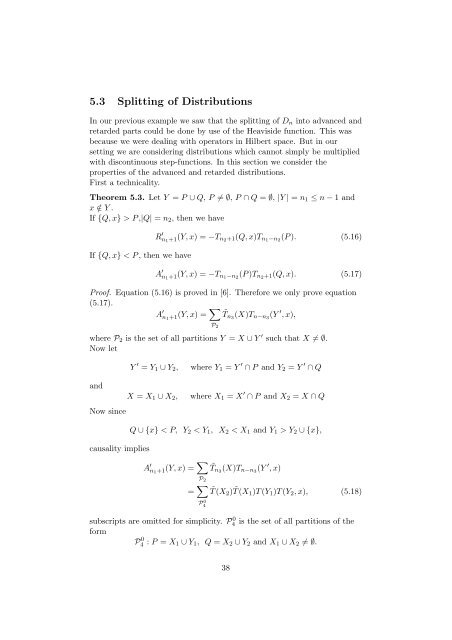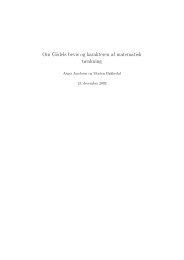Master Dissertation
Master Dissertation
Master Dissertation
Create successful ePaper yourself
Turn your PDF publications into a flip-book with our unique Google optimized e-Paper software.
5.3 Splitting of Distributions<br />
In our previous example we saw that the splitting of Dn into advanced and<br />
retarded parts could be done by use of the Heaviside function. This was<br />
because we were dealing with operators in Hilbert space. But in our<br />
setting we are considering distributions which cannot simply be multiplied<br />
with discontinuous step-functions. In this section we consider the<br />
properties of the advanced and retarded distributions.<br />
First a technicality.<br />
Theorem 5.3. Let Y = P ∪ Q, P = ∅, P ∩ Q = ∅, |Y | = n1 ≤ n − 1 and<br />
x /∈ Y .<br />
If {Q, x} > P ,|Q| = n2, then we have<br />
If {Q, x} < P , then we have<br />
R ′ n1+1(Y, x) = −Tn2+1(Q, x)Tn1−n2 (P ). (5.16)<br />
A ′ n1+1(Y, x) = −Tn1−n2 (P )Tn2+1(Q, x). (5.17)<br />
Proof. Equation (5.16) is proved in [6]. Therefore we only prove equation<br />
(5.17).<br />
A ′ n1+1(Y, x) = <br />
˜Tn3 (X)Tn−n3 (Y ′ , x),<br />
where P2 is the set of all partitions Y = X ∪ Y ′ such that X = ∅.<br />
Now let<br />
and<br />
Now since<br />
causality implies<br />
P2<br />
Y ′ = Y1 ∪ Y2, where Y1 = Y ′ ∩ P and Y2 = Y ′ ∩ Q<br />
X = X1 ∪ X2, where X1 = X ′ ∩ P and X2 = X ∩ Q<br />
Q ∪ {x} < P, Y2 < Y1, X2 < X1 and Y1 > Y2 ∪ {x},<br />
A ′ n1+1(Y, x) = <br />
˜Tn3 (X)Tn−n3 (Y ′ , x)<br />
P2<br />
= <br />
˜T (X2) ˜ T (X1)T (Y1)T (Y2, x), (5.18)<br />
P 0 4<br />
subscripts are omitted for simplicity. P 0 4<br />
form<br />
is the set of all partitions of the<br />
P 0 4 : P = X1 ∪ Y1, Q = X2 ∪ Y2 and X1 ∪ X2 = ∅.<br />
38



